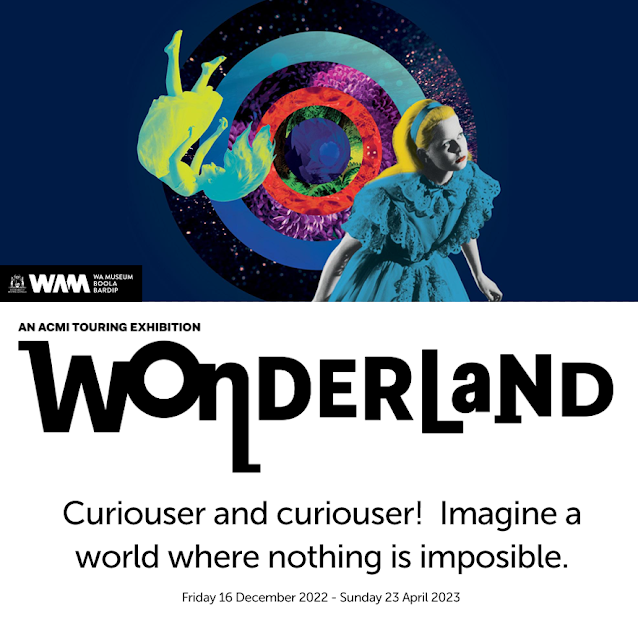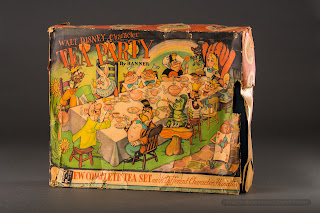Research continues for the book. Recently I acquired something I did not know existed, although I should have know since it is a common enough practice.
Saturday, December 31, 2022
Libby's In-Store Broadside
Friday, December 9, 2022
Australia Here We Come - Again!
The ACMI Wonderland Exhibition tour is back on the road after a 2 1/2 year break due to COVID, and its next stop is Perth, Australia at the WA Museum Boola Bardip. The lovely people at ACMI are again flying us down to help celebrate the opening and re-start of this amazing exhibition and its tour across the globe. Any readers in Western Australia be sure to visit, and if you happen to be there December 15-18, introduce yourselves. We'll be the two Americans wearing loud Alice-themed clothing ;-)
Sunday, August 28, 2022
Two Down, Thirteen To Go!
Well, I *think* I've hit another milestone today with the book. I'm not sure, but I'm fairly certain I've completed the first draft of another chapter, that on Toys, Games, and Puzzles. Time will tell (meaning once we get the collection back on display) whether or not I missed something, but I feel pretty good about it. I may yet make my 2026 deadline! This was a big one, 28 sections, but hey, gotta be complete :-)
Saturday, August 20, 2022
Banner Plastics Tea Set from 1955
Banner Plastics made a variety of plastic toys for children, but specialized in tea sets and toy trucks.
The Banner Plastic Corporation was founded in 1944 in the Bronx, NY by
two men, Emanuel M. Pressner and Bernard Schiller, although Bernard Schiller
would not stay long with the company. In
1950, the company moved from the Bronx to Patterson, New Jersey where they
purchase a former aeronautical engineering plant. During the mid-1950s, the company greatly
expanded its product line, adding new metal toys to complement their line of
plastic toys, including tea set, blocks, and trucks. Into the 1960s they continued to expand their
tea set line to additional kitchen toys and dishes, licensing such brands as
Pyrex, Corning Ware, and others. They
continued to acquire other toy companies further expanding their lines with garden
toys, military toys, and space toys. But
by 1965 the company had contracted to the point that their catalog contained
only 50 items, that catalog would be their last as they filed for bankruptcy
that year, and by 1967 had been purchased by Tal-Cap, a large toy conglomerate
in Minnesota.
Banner held a Disney license for only two years, between 1955 and
1956. An ad from an issue of Playthings
from April 1955 shows the Alice in Wonderland tea set, but in the picture is a
plate with an image of Thumper, so it is likely that they made a few different
tea sets, but to date I've not seen any other than the Alice set. Tomart also lists stacking blocks and a Davy
Crockett covered wagon, neither of which I am familiar with.
Items are marked Banner Plastics Corp., Paterson, NJ, and depending on the year and the package, may have the company logo featuring two kids waving banners.
The Alice in Wonderland tea set was released in 1955 at the beginning of Banner's Disney license, the Playthings ad from April clearly shows it (well, not that clearly but I've highlighted it in the second image).
No specific pricing for the Alice set has surfaced, but comparable
sets of the era retailed at $3.98, which would be $40 in today's dollars.
The Banner tea set is amazingly cool. For many years it was unclear exactly what was contained in this mythical toy, since only the tin pieces showed up the majority of the time. However, the full tea set is actually pictured on the large tray so it was known what should have been included. Eventually the plastic pieces surfaced, and later a full set in the original box was discovered. A second set in the box was seen in the early 2000s and that is the set pictured here.
The tin pieces consist of four plates, four saucers, and the large tray. The plastic pieces include four cups, four knives, four forks, four spoons, a creamer, a sugar bowl, a teapot, and a teapot stand - in loose sets the teapot stand is often missing. Perhaps the coolest feature of the set is that all the handles are characters!
Tuesday, August 16, 2022
Trimfoot Shoes Alice in Wonderland Advertising Manual - The Alice Look!
This thing is truly amazing, 16 pages plus cover and one insert of advertising gold for Trimfoot Shoes. The campaign was called "The 'Alice' Look" and was centered around the marketing of a series of five different girls' shoes styles based on Alice.
The manual contains sample ads, copy, artwork, you name it, for you and your local shoestore to maximize your "Alice" campaign. It even pictures some Stensgaard displays that could be ordered to enhance your window treatments.
Thursday, June 30, 2022
We Made Some Ink! Washingtonian Magazine July 2022
Being residents of the greater DMV (that's DC, Maryland, Virginia for those not in the know), the Washingtonian is our version of New York Magazine or Los Angeles Magazine, with features on local interest, published monthly. And this month has a one-page feature on the Alice collection, only 6 years in the making! Pictures below of the cover and our single page, and then an annotated page.
- Regal Mad Hatter Teapot
- Gund Queen of Hearts Vinylite Stuffed Toy
- Regal White Rabbit Creamer
- Zaccagnini (Italy) Cheshire Cat Figure
- Disneyland White Rabbit Press/VIP Gift from 1984 Attraction Re-Opening
- Neevel Doll Wardrobe Case
- Lars (Italy) Bill the Lizard Stuffed Toy
- 1970s Disneyland Child's Sunglasses
- National Leather Mfg Co Schoolbag
- Madame Alexander Doll
- Larceram (France) Lamp
- Chad Valley (England) Nursery Play-Toy Tin Stacking Blocks
- Unknown Tweedledee/dum String Holder (likely unlicensed)
- Enesco Head Vase
- Sni-Dor (Canada) Record Player
- Goebel (Germany) Dodo Smoker Ashtray
- Unknown (England) Meal Time Dish Set
- Hassenfeld Bros (Hasbro) Nurse Kit
- Linemar Mad Hatter's Sky-View Taxi Tin Friction Toy
- US Time Watch in Teacup Box
Sunday, June 19, 2022
Original Release Australian Press Book
Otherwise known in the US as campaign book, this press book contains lots of sample articles, ad mats, posters, and merchandise specific to the Australian market. Super cool.































